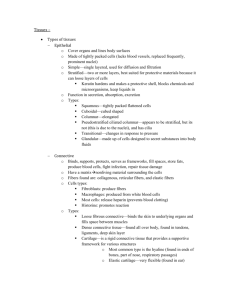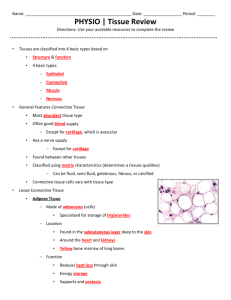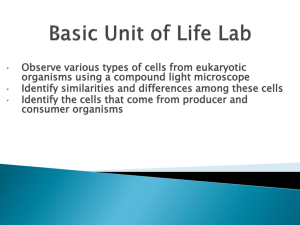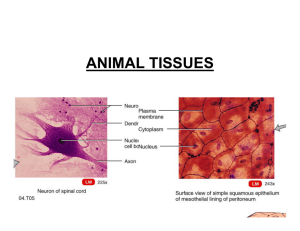Histology Lab to complete
advertisement
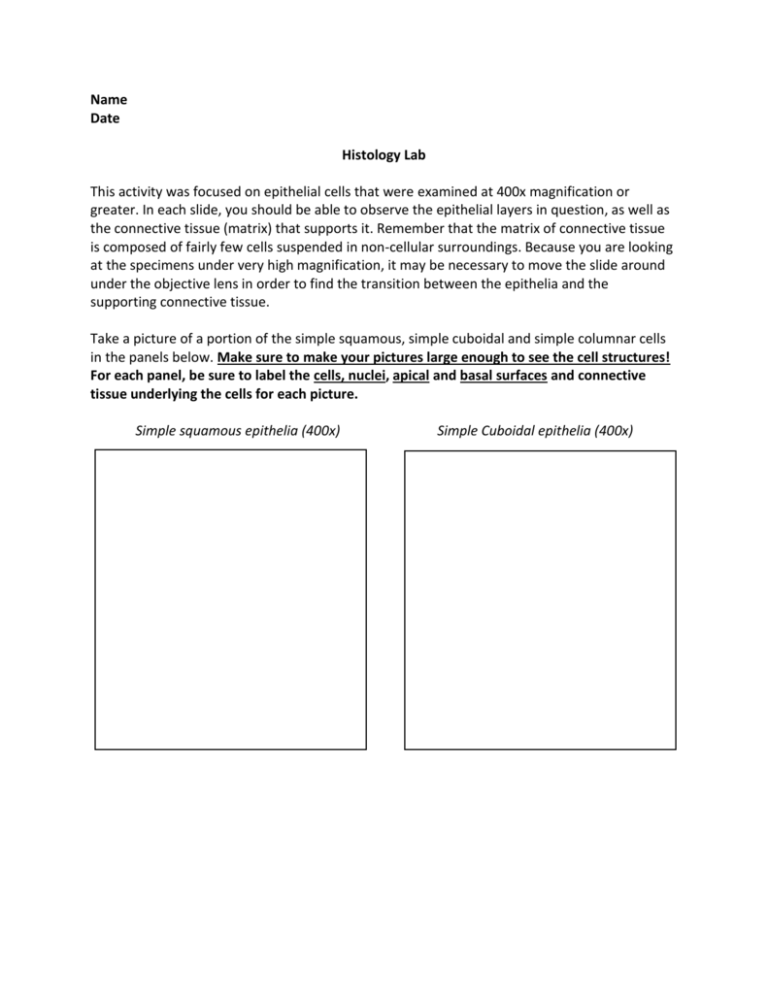
Name Date Histology Lab This activity was focused on epithelial cells that were examined at 400x magnification or greater. In each slide, you should be able to observe the epithelial layers in question, as well as the connective tissue (matrix) that supports it. Remember that the matrix of connective tissue is composed of fairly few cells suspended in non-cellular surroundings. Because you are looking at the specimens under very high magnification, it may be necessary to move the slide around under the objective lens in order to find the transition between the epithelia and the supporting connective tissue. Take a picture of a portion of the simple squamous, simple cuboidal and simple columnar cells in the panels below. Make sure to make your pictures large enough to see the cell structures! For each panel, be sure to label the cells, nuclei, apical and basal surfaces and connective tissue underlying the cells for each picture. Simple squamous epithelia (400x) Simple Cuboidal epithelia (400x) Simple Columnar Epithelia (400x) Ciliated Columnar Epithelia (400x) Of the three types of epithelial cells that you observed, what are four characteristics that are common between all types? 1. 2. 3. 4. Also be sure to examine stratified epithelia (skin slides), paying attention to how some cells that make up skin are increasingly keratinized as they progress from the inner layers (basement membrane) out to the outer surface. These cells will appear flat and scaly as they near the external environment. How would you describe the difference between epithelium and connective tissue? Activity 2. Connective Tissue You should observe the following types of connective tissue under the microscope at 400x Areolar Dense regular connective tissue Fibrocartilage Adipose Tissue Hyaline Cartilage Bone Connective tissue has a much different structure than the epithelial tissue that you have observed. It consists mainly of non-living fibers and ground substance, with cells interspersed throughout. The three types fibers found in this matrix are collagen, elastic and reticular fibers. Collagen fibers (usually pink) are thick and provide reinforcement, elastin fibers (usually purple) are thinner and allow for stretch, while reticular fibers (variable color) act as a net to hold the tissue together in all directions. 1. Observe and take a picture of areolar tissue. Label the collagen fibers, elastin fibers and fibroblasts (cells that produce the proteins fibers in the matrix). 2. Adipose tissue contains cells with a vacuole that pushes the nucleus out to the border of the cell. Take a picture of a portion of adipose tissue and label the a vacuole, nucleus and a cell membrane. Areolar Connective Tissue (400x) Adipose Tissue (400x) 3. Dense regular connective tissue gets its name from its closely packed parallel collagen fibers. Take a picture of this tissue, labeling the collagen fibers and fibroblast nuclei. This tissue makes up tendons and ligaments, as they need great strength to function properly. However, tendons are very slow to heal when injured. Why? Dense regular connective tissue (400x) Cartilage Cartilage is made up of cells called chondroblasts which secrete reinforcing fibers and ground substance. As they secrete these products, they trap themselves in cavities called lacunae, which are usually seen as a white ring or “bubble” around the cell. Once surrounded by a lacunae, the chondroblasts are considered mature and are then called chondrocytes. Take a picture of a portion of hyaline cartilage and label the chondrocytes and lacunae. Hyaline Cartilage (400x) Hyaline (glassy) cartilage is the most abundant type in the human body. Where are three places in which it can be found? 1. 2. 3. Fibrocartilage is a very strong, shock absorbing tissue, which is why it functions well as disks that protect the vertebrae. Take a picture of a portion of fibrocartilage and label the chondrocytes and lacunae. Fibrocartilage (400x) Where can you find fibrocartilage? Bone Bone is mainly composed of an extracellular matrix which gives it great strength. Osteocytes are bone cells. The bone you are observing is a chip of dried bone that has been ground very thin (therefore the cells are lacking) but there are holes where the cells used to be. Take a picture of a portion of the bone and label the cells and the Haversian canal. Compact Bone (400x) Activity 3. Muscle tissue Observe a smooth, skeletal and cardiac muscle slide at 400x. Draw a portion of each slide and outline and label an individual cell in each type. Be sure to label the nuclei and any striations. For cardiac muscle, please label at least one intercalated disk. Skeletal Muscle (400x) Cardiac Muscle (400x) Smooth Muscle (400x) Fill in the following table regarding the muscle type characteristics. Use your lab guide “A Brief Atlas of the Human Body” to help you. Characteristic Number of nuclei per cell Striations Present? Cell Shape? Intercalated disks? Voluntary or Involuntary? Skeletal muscle Cardiac Muscle Smooth Muscle Activity 4. Nervous Tissue Observe peripheral nerve tissue. On these slide you will see two different section (or slices) of nerve tissue. Note that even though both are from the same tissue preparation, the structure looks very different. Take a picture of each view below and be sure to label the cell body and the axons in each. Neuron Cross section (400x) Neuron Longitudinal (long axis) section (400x) Why does each section look different even though it is the same tissue?

